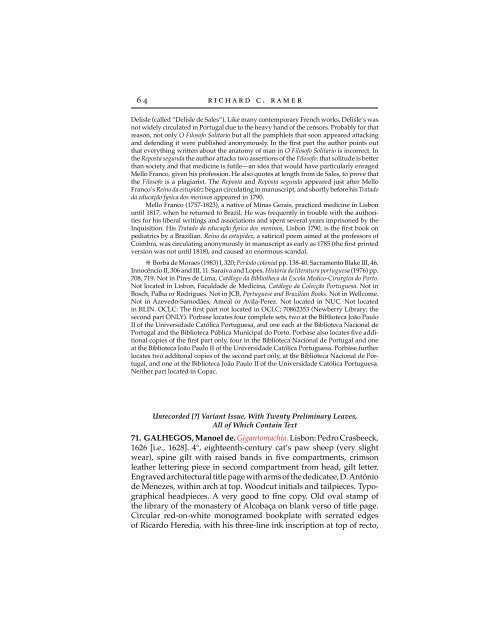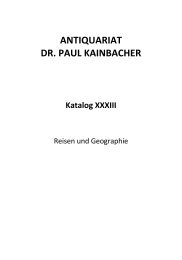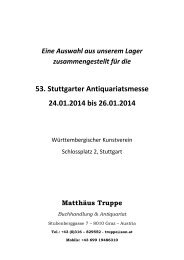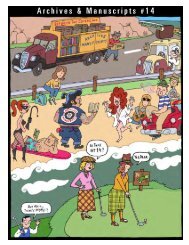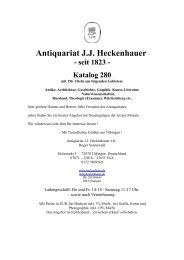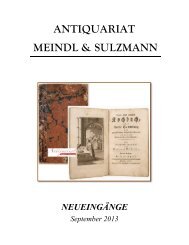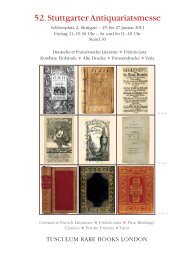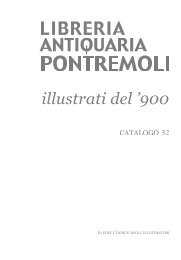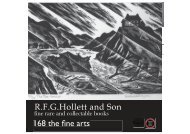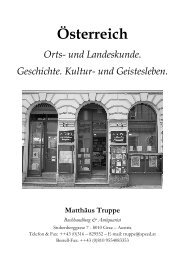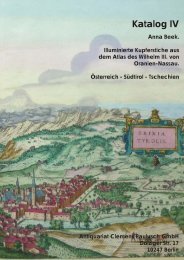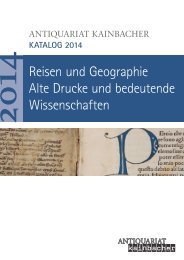Recent Acquisitions - Richard C. Ramer Old & Rare Books
Recent Acquisitions - Richard C. Ramer Old & Rare Books
Recent Acquisitions - Richard C. Ramer Old & Rare Books
You also want an ePaper? Increase the reach of your titles
YUMPU automatically turns print PDFs into web optimized ePapers that Google loves.
64<br />
richard c. ramer<br />
Delisle (called “Delisle de Sales”). Like many contemporary French works, Delisle’s was<br />
not widely circulated in Portugal due to the heavy hand of the censors. Probably for that<br />
reason, not only O Filosofo Solitario but all the pamphlets that soon appeared attacking<br />
and defending it were published anonymously. In the first part the author points out<br />
that everything written about the anatomy of man in O Filosofo Solitario is incorrect. In<br />
the Reposta segunda the author attacks two assertions of the Filosofo: that solitude is better<br />
than society and that medicine is futile—an idea that would have particularly enraged<br />
Mello Franco, given his profession. He also quotes at length from de Sales, to prove that<br />
the Filosofo is a plagiarist. The Reposta and Reposta segunda appeared just after Mello<br />
Franco’s Reino da estupidez began circulating in manuscript, and shortly before his Tratado<br />
da educação fysica dos meninos appeared in 1790.<br />
Mello Franco (1757-1823), a native of Minas Gerais, practiced medicine in Lisbon<br />
until 1817, when he returned to Brazil. He was frequently in trouble with the authorities<br />
for his liberal writings and associations and spent several years imprisoned by the<br />
Inquisition. His Tratado da educação fysica dos meninos, Lisbon 1790, is the first book on<br />
pediatrics by a Brazilian. Reino da estupidez, a satirical poem aimed at the professors of<br />
Coimbra, was circulating anonymously in manuscript as early as 1785 (the first printed<br />
version was not until 1818), and caused an enormous scandal.<br />
j Borba de Moraes (1983) I, 320; Período colonial pp. 138-40. Sacramento Blake III, 46.<br />
Innocêncio II, 306 and III, 11. Saraiva and Lopes, História da literatura portuguesa (1976) pp.<br />
708, 719. Not in Pires de Lima, Catálogo da Bibliotheca da Escola Medico-Cirurgica do Porto.<br />
Not located in Lisbon, Faculdade de Medicina, Catálogo da Colecção Portuguesa. Not in<br />
Bosch, Palha or Rodrigues. Not in JCB, Portuguese and Brazilian <strong>Books</strong>. Not in Wellcome.<br />
Not in Azevedo-Samodães, Ameal or Avila-Perez. Not located in NUC. Not located<br />
in RLIN. OCLC: The first part not located in OCLC; 70862353 (Newberry Library; the<br />
second part ONLY). Porbase locates four complete sets, two at the Biblioteca João Paulo<br />
II of the Universidade Católica Portuguesa, and one each at the Biblioteca Nacional de<br />
Portugal and the Biblioteca Pública Municipal do Porto. Porbase also locates five additional<br />
copies of the first part only, four in the Biblioteca Nacional de Portugal and one<br />
at the Biblioteca João Paulo II of the Universidade Católica Portuguesa. Porbase further<br />
locates two additonal copies of the second part only, at the Biblioteca Nacional de Portugal,<br />
and one at the Biblioteca João Paulo II of the Universidade Católica Portuguesa.<br />
Neither part located in Copac.<br />
Unrecorded [?] Variant Issue, With Twenty Preliminary Leaves,<br />
All of Which Contain Text<br />
71. GALHEGOS, Manoel de. Gigantomachia. Lisbon: Pedro Crasbeeck,<br />
1626 [i.e., 1628]. 4°, eighteenth-century cat’s paw sheep (very slight<br />
wear), spine gilt with raised bands in five compartments, crimson<br />
leather lettering piece in second compartment from head, gilt letter.<br />
Engraved architectural title page with arms of the dedicatee, D. António<br />
de Menezes, within arch at top. Woodcut initials and tailpieces. Typographical<br />
headpieces. A very good to fine copy. <strong>Old</strong> oval stamp of<br />
the library of the monastery of Alcobaça on blank verso of title page.<br />
Circular red-on-white monogramed bookplate with serrated edges<br />
of Ricardo Heredia, with his three-line ink inscription at top of recto,


